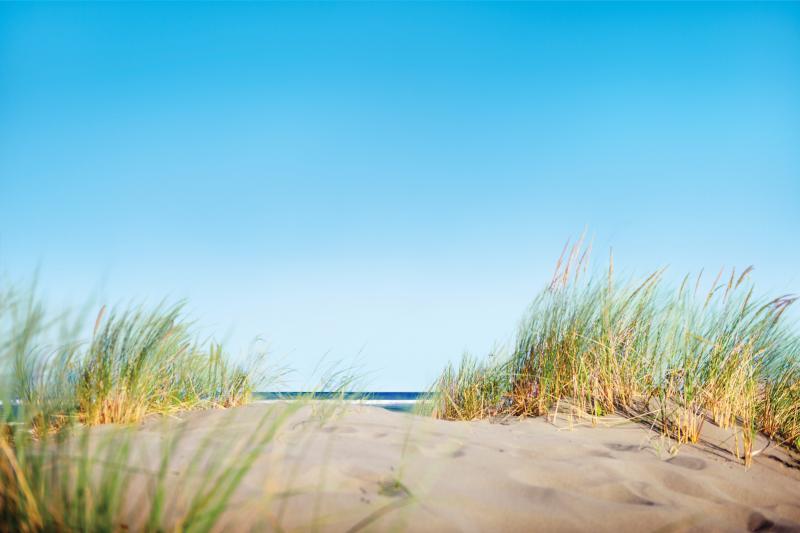I’m walking from the Hawk Watch at the edge of Cape Henlopen State Park’s public beach parking lot with Richard Julian. His official title is interpretive program manager, “connecting people to resources.” A Connecticut native with a BS in ecology and a master’s in conservation biology, he’s worked at the park for 16 years. “I love the cool habitat: the ocean, the marsh, the maritime forest.”
“There’s 8,000 feet of sand underneath us,” he observes. Delaware’s coastal plain is wash-off from mountains surrounding what is now the Delaware Water Gap that were once higher than the Himalayas. “Archeologists have found pre-European artifacts here.”
As we chat, his colleague accompanying us spots tiny dots like freckles that have suddenly appeared on her arm. “Ticks,” says Julian, pointing to the weeping lovegrass where she had been standing. “They like to live there.” She looks worried. “There’s a margin of safety after they bite you.” She scurries to the ocean to wash them off.
“We’ve got lots of them,” he continues, talking about ticks. “They’re vectors for transmitting disease, injecting fluids into prey to suck out mammal blood that fertilizes their eggs.” Worst may be the painless bite of the Lone Star tick that can produce a life-threatening allergic reaction – airways constrict, blood pressure drops - when you eat meat.
“Weeping lovegrass isn’t native,” he explains. It was introduced in World War II for stabilization and concealment when this was Fort Miles, a gunnery base to defend the Delaware Bay from German battleships.
Heading along the path, we pause at a kind of shallow vale, primary dunes along the ocean ahead of us, a ridge of secondary dunes several hundred yards behind, on which sit the concrete remains of Battery Hunter and its six-inch guns.
He surveys the landscape, off limits to pedestrians, that straddles the narrow path. To my uneducated eye, it all appears to be undifferentiated pine scrub. I ask what he sees. “A hidden resource most people overlook. They don’t realize how important it is to their beach experience.
“It’s the dunes that hold this whole coastline together,” said Richard. “Shrubs need the dunes.” First come grasses, spreading wide and stabilizing the shifting sand. The primary dunes serve to buffer the plants behind them, minimizing the impact of salt and sand spray.
Cape Henlopen is located at an ecological axis, the northernmost point of the southern range, the southernmost point of the northern range. Which means that growing in the park are both northern bayberry (as in the colonists’ bayberry candles) that extends into Greenland, and wax myrtle, native to the Caribbean and a favorite winter food of the myrtle warbler.
Ditto the southern loblolly pine (after the red maple, the most common tree in the United States) and the northern pitch pine found in the forests of Maine and Quebec.
What the flora of Cape Henlopen have in common is the ability to thrive in sandy, alkaline soil with few nutrients, and subject to ocean spray and salt. They also have to withstand powerful wind events, so they’ve evolved to be flexible, to bend rather than break.
The pines closest to the shore have been sculpted into distorted shapes, what Richard calls “nature’s topiary,” abraded by wind-driven sand blasting their trunks.
Richard points out an area that looks greyish-green. “The lighter color of the plants dissipates heat.”
Then we see a low-lying splotch of bright green in the middle distance. Phragmites grass. The clawing surf of big nor’easters carves out swales in the sand, broad troughs that bring the freshwater table closer to the surface. That makes for patches of wetland, prime habitat for this invasive reed that requires constant environmental stewardship lest it drive out native plants and the food chains that depend on them.
The entire coastal ecological system, ending with the towering pines of the inland maritime forest, pivots around the dunes. That’s why their protection is so vital. People walking on them compress the sand underfoot. “Beach grasses won’t grow in compacted soil; it’s kryptonite to them.” And these grasses provide the architectural scaffolding that enables dunes to remain intact.
Along the water’s edge, foraging sandpipers scurry back and forth. They hadn’t been around a week earlier, so I ask what’s going on. “They’re migrating south from the tundra.”
As we end our walk, I ask Richard what he as a naturalist ponders these days. The unexpected question makes him pause a moment, then say, “Given sea-level concerns and the dunes being blown west, I’d have to say the impact climate change is going to have on the park.”





















































